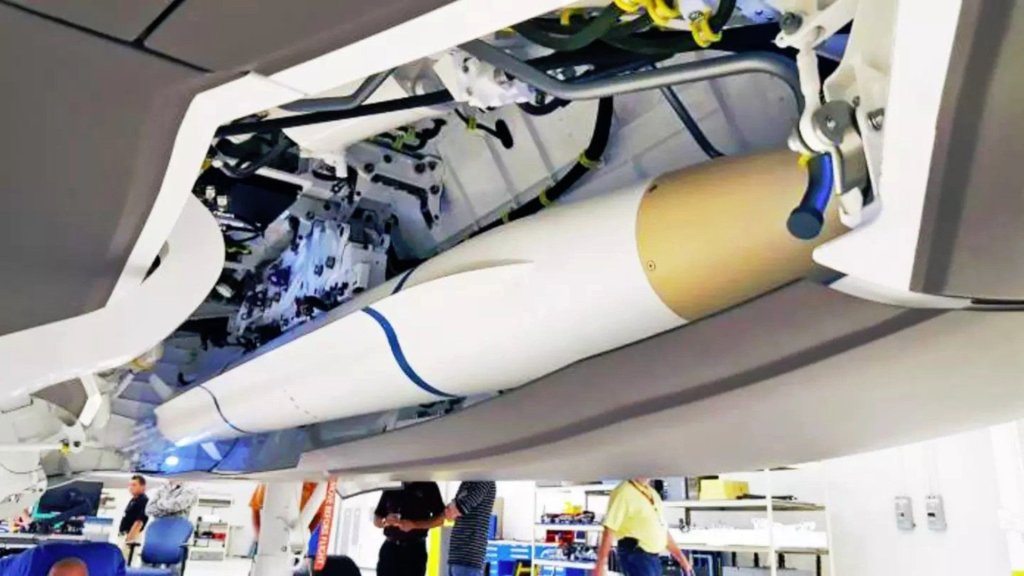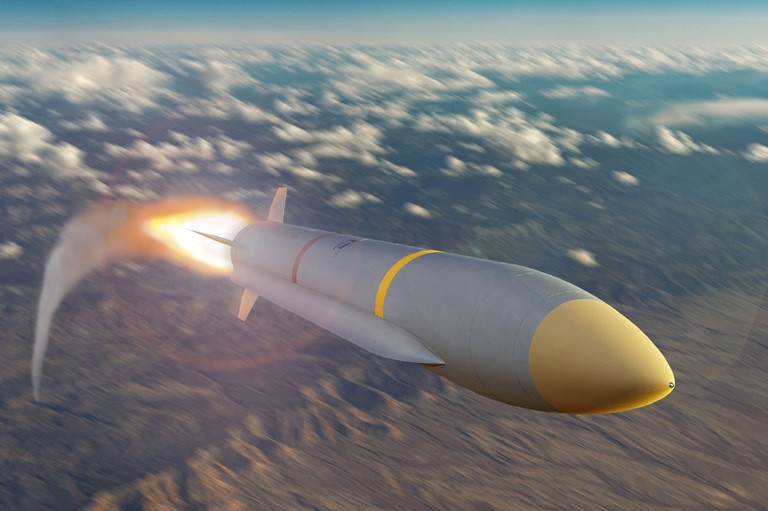Flight testing of the U.S. Air Force’s Stand-In Attack Weapon (SiAW) missile is now set to begin following the delivery of an initial test article. Derived from the AGM-88G missile designed primarily to punch holes in enemy air defenses, SiAW is under development to offer a broader high-speed strike capability against time-sensitive ground targets, including ballistic and cruise missile launchers, air and missile defense nodes, electronic warfare systems, and even anti-satellite weapons.
Northrop Grumman, the prime contractor for the AGM-88G and SiAW, released a brief statement today about the delivery of the new test missile, “which is designed to verify that the launch aircraft can safely carry and separate the weapon,” along with a picture of it, seen at the top of this story. The company received its latest SiAW contract, valued at approximately $705 million, in September 2023. The U.S. Navy has already been leading the very active development of the AGM-88G, also known as the Advanced Anti-Radiation Guided Missile-Extended Range (AARGM-ER), for years now. The first AARGM-ER live-fire flight test occurred in 2021.

Specific details about range, speed, and other capabilities of the SiAW, as well as AGM-88G, remain limited. It is worth noting that Lockheed Martin unveiled a hypersonic missile called Mako, which it said was originally developed for the SiAW competition, earlier this year. We don’t know whether or not this means that SiAW (and by extension the AARGM-ER) might then also be capable of reaching hypersonic or near-hypersonic speeds, including in a terminal stage sprint.
Lockheed Martin, as well as L3Harris, withdrew from the running for continued work on SiAW before Northrop Grumman received its contract last year.
It is also known that AARGM-ER, at least in its baseline configuration, shares the same guidance and flight control systems as the preceding combat-proven AGM-88E AARGM. As such, as The War Zone has written previously:
“AARGM-ER contains a multi-mode guidance package containing a GPS-assisted inertial navigation system, as well as a millimeter-wave radar that can locate targets even if they stop emitting radiofrequency or other signals or even begin to move. The missile’s guidance and datalink package also have the capability to network with off-board sources, meaning a launching aircraft can fire the weapon without even having acquired a target’s emissions, instead relying on other platforms’ data to target and prosecute an attack. The anti-radiation missile can also reportedly relay data in its final moments to confirm whether or not it successfully struck its intended target.”

With the multiple guidance mode options, AARGM and AARGM-ER also already have a secondary general air-to-surface strike capability, including against ships and targets ashore.

How exactly SiAW will differ from AARGM-ER, which the Air Force is also acquiring, to provide expanded capability against a broader array of target sets is unclear, but official budget documents explicitly mention an “improved warhead/fuze.”
“The Stand-in Attack Weapon (SiAW) system will provide capability to strike rapidly re-locatable targets that create the Anti-Access/Area Denial (A2/AD) environment,” the Air Force’s 2025 Fiscal Year budget request, released back in March, also says. “SiAW targets include Theater Ballistic Missile Launchers, Land Attack and Anti-Ship Cruise Missile Launchers, Jammers, Anti-Satellite Systems, and Integrated Air Defense Systems.”
SiAW, as described now, offers a capability that is particularly relevant to the U.S. military’s current over-arching planning focus around a potential high-end conflict with China. The Chinese People’s Liberation Army has already made considerable investments in the development and fielding of more advanced and longer-range air defense, anti-ship, and electronic warfare capabilities, as well as ones intended to challenge America’s historic dominance in the space domain. Having multiple ways to suppress and destroy these A2/AD capabilities, and do so quickly and effectively across a broad front, will be critical to succeeding in any future major fight in the Pacific region.
With all this in mind, it is not surprising that the Air Force plans for its F-35A stealth fighters to be the first aircraft in inventory to be armed with SiAWs. F-35As will also be able to carry the missiles in their internal bays, allowing them to employ this new capability while in their most stealthy configuration. F-35As and Cs will also be able to carry AARGM-ER internally.

The Air Force has also said that the goal is for SiAW to be part of the arsenal of other unspecified “Future Advanced Aircraft.” The service has been working toward acquiring a new sixth-generation crewed stealth combat jet as part of its Next Generation Air Dominance (NGAD) initiative, but the future of that effort is now very uncertain, as you can read more about here. The B-21 Raider stealth bomber and various different drones might also be SiAW launch platforms.
SiAW, as well as AARGM-ER, could also offer non-stealthy platforms a useful tool for engaging air defense and other targets that might suddenly pop up. Depending on the weapon’s range, it might be possible to employ it from beyond the reach of certain threats using third-party targeting data.
Other branches of the U.S. military, as well as foreign allies and partners (a number of which are already moving to buy AARGM-ERs), could be interested in SiAW, as well. Northrop Grumman has also been working on surface-to-surface strike derivatives of the AARGM-ER/SiAW family, which could be fired from ground-based launchers or ships.

As it stands now, the Air Force’s SiAW testing plan, which is benefitting greatly from the work already done on AARGM-ER, includes at least four live-fire flights. After that, Northrop Grumman says the goal is for the service to take “delivery of SiAW leave-behind prototype missiles and test assets” to support continued development and work toward operational fielding. The service hopes to reach initial operational capability with the missile sometime in 2026.
The delivery of the new SiAW asset is another important step forward in the ongoing development of what could be a particularly critical component of the Air Force’s future arsenal.
Contact the author: joe@twz.com
